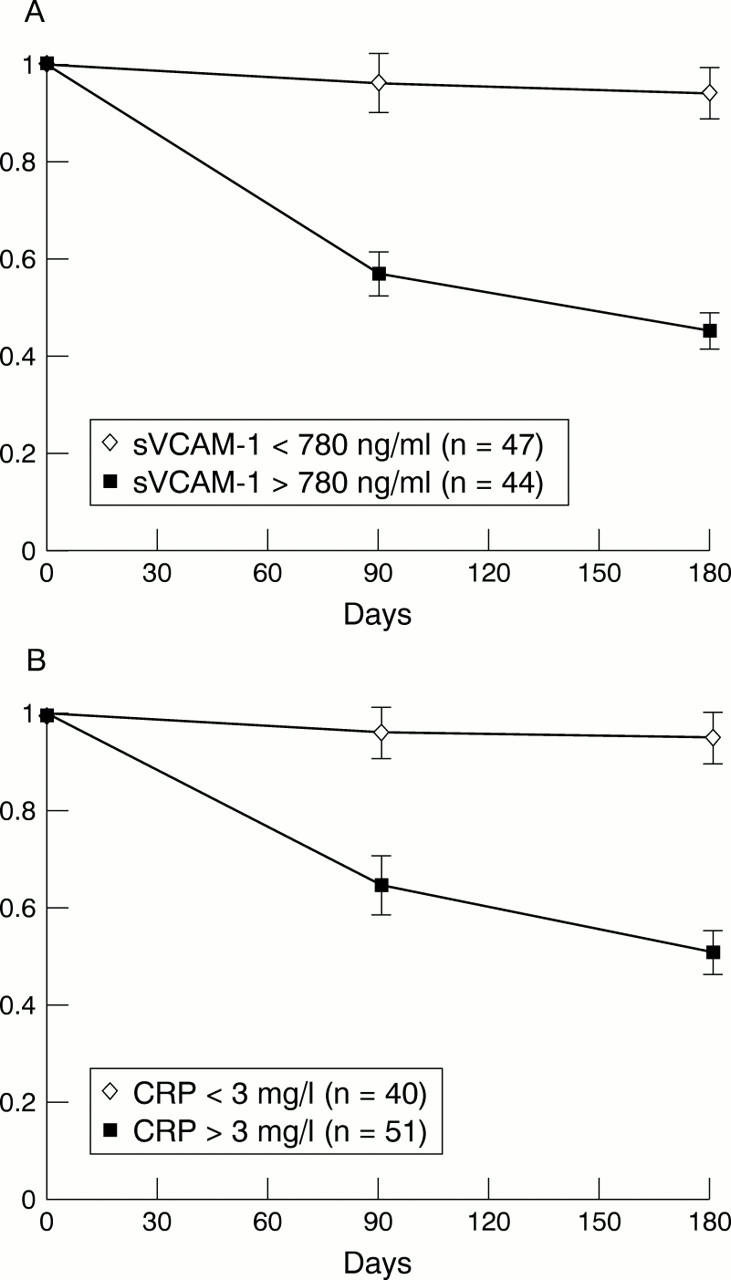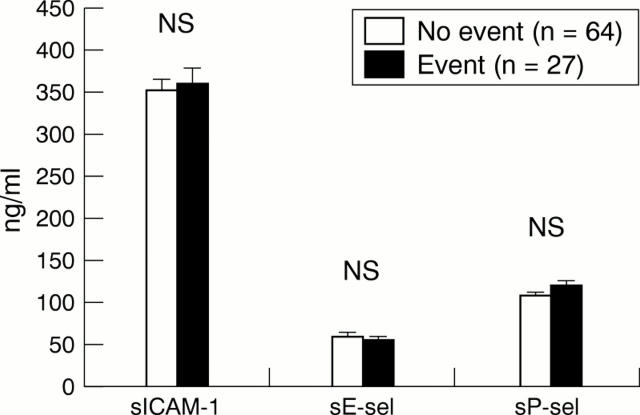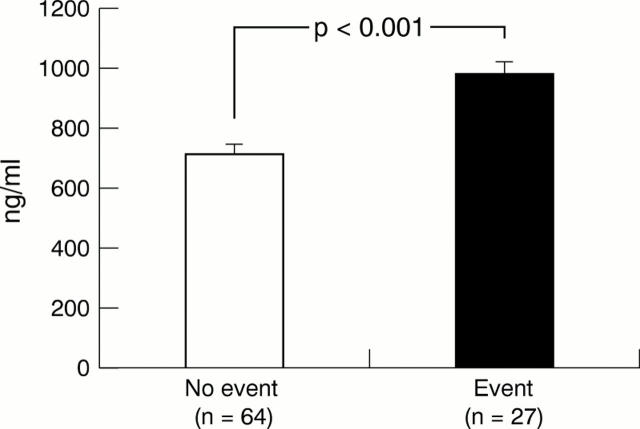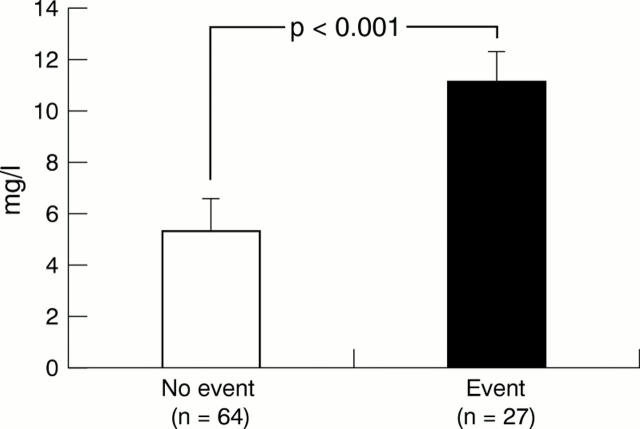Abstract
OBJECTIVE—To assess prospectively the prognostic value of soluble cellular adhesion molecules (CAMs) in patients with unstable angina and non-Q wave myocardial infarction and to compare their prognostic accuracy with that of C reactive protein (CRP). DESIGN AND SETTING—Prospective observational study of patients presenting acutely with unstable angina and non-Q wave myocardial infarction to a single south Dublin hospital. METHODS—Patients with Braunwald IIIA unstable angina and non-Q wave myocardial infarction had serum samples taken at presentation before initiation of antithrombotic treatment and were followed for six months. The primary end point was the occurrence of major adverse cardiovascular events (recurrent unstable angina, non-fatal myocardial infarction, and cardiovascular death) at six months. Concentrations of soluble intercellular adhesion molecule-1 (sICAM-1), soluble vascular cell adhesion molecule-1 (sVCAM-1), soluble endothelial selectin, and soluble platelet selectin were measured using an enzyme linked immunosorbent assay technique. CRP was measured with an immunophelometric assay. RESULTS—91 patients (73 men and 18 women, mean (SD) age 61 (11) years) were studied; 27 patients (30%) had major adverse cardiac events during the six months of follow up. Concentration of CRP were significantly raised in patients who had an ischaemic event (mean (SEM) 11.5 (6.4) mg/l v 5.4 (2.5) mg/l, p < 0.001). Concentrations of sVCAM-1 were also significantly raised in the ischaemic event group (979 (30) ng/ml v 729 (22) ng/ml, p < 0.001). Both sVCAM-1 and CRP concentrations correlated strongly with the occurrence of an adverse event. The sensitivity of CRP > 3 mg/l and sVCAM-1 > 780 ng/ml for predicting future events was > 90%. There was no difference in concentrations of sICAM-1, soluble endothelin selectin, or soluble platelet selectin between event and non-event groups. CONCLUSION—Raised concentrations of sVCAM-1 and CRP are predictive of an increased risk of major adverse cardiovascular events six months after presentation with unstable angina and non-Q wave myocardial infarction. These findings suggest that the intensity of the vascular inflammatory process at the time of presentation is a determinant of clinical outcome in unstable coronary artery disease. Keywords: cell adhesion molecules; risk stratification; unstable angina
Full Text
The Full Text of this article is available as a PDF (121.9 KB).
Figure 1 .
Concentrations of soluble intercellular adhesion molecule-1 (sICAM-1), soluble endothelial selectin (sE-sel), and soluble platelet selectin (sP-sel) at presentation in event and non-event groups.
Figure 2 .
Concentrations of soluble vascular cell adhesion molecule-1 (sVCAM-1) at presentation in event and non-event groups.
Figure 3 .

(A) Event free survival curves for patients divided according to concentration of sVCAM-1 (< or > 780 ng/ml). (B) Event free survival curves for patients divided according to concentration of C reactive protein (CRP) (< or > 3 mg/l).
Figure 4 .
Concentrations of serum CRP at presentation in non-event and event groups.
Selected References
These references are in PubMed. This may not be the complete list of references from this article.
- Berk B. C., Weintraub W. S., Alexander R. W. Elevation of C-reactive protein in "active" coronary artery disease. Am J Cardiol. 1990 Jan 15;65(3):168–172. doi: 10.1016/0002-9149(90)90079-g. [DOI] [PubMed] [Google Scholar]
- Biasucci L. M., Liuzzo G., Grillo R. L., Caligiuri G., Rebuzzi A. G., Buffon A., Summaria F., Ginnetti F., Fadda G., Maseri A. Elevated levels of C-reactive protein at discharge in patients with unstable angina predict recurrent instability. Circulation. 1999 Feb 23;99(7):855–860. doi: 10.1161/01.cir.99.7.855. [DOI] [PubMed] [Google Scholar]
- Blann A. D., Amiral J., McCollum C. N. Circulating endothelial cell/leucocyte adhesion molecules in ischaemic heart disease. Br J Haematol. 1996 Nov;95(2):263–265. doi: 10.1046/j.1365-2141.1996.d01-1921.x. [DOI] [PubMed] [Google Scholar]
- Braunwald E. Unstable angina. A classification. Circulation. 1989 Aug;80(2):410–414. doi: 10.1161/01.cir.80.2.410. [DOI] [PubMed] [Google Scholar]
- Caligiuri G., Liuzzo G., Biasucci L. M., Maseri A. Immune system activation follows inflammation in unstable angina: pathogenetic implications. J Am Coll Cardiol. 1998 Nov;32(5):1295–1304. doi: 10.1016/s0735-1097(98)00410-0. [DOI] [PubMed] [Google Scholar]
- Davies M. J., Thomas A. C. Plaque fissuring--the cause of acute myocardial infarction, sudden ischaemic death, and crescendo angina. Br Heart J. 1985 Apr;53(4):363–373. doi: 10.1136/hrt.53.4.363. [DOI] [PMC free article] [PubMed] [Google Scholar]
- Dinerman J. L., Mehta J. L., Saldeen T. G., Emerson S., Wallin R., Davda R., Davidson A. Increased neutrophil elastase release in unstable angina pectoris and acute myocardial infarction. J Am Coll Cardiol. 1990 Jun;15(7):1559–1563. doi: 10.1016/0735-1097(90)92826-n. [DOI] [PubMed] [Google Scholar]
- Fuster V., Badimon L., Badimon J. J., Chesebro J. H. The pathogenesis of coronary artery disease and the acute coronary syndromes (1). N Engl J Med. 1992 Jan 23;326(4):242–250. doi: 10.1056/NEJM199201233260406. [DOI] [PubMed] [Google Scholar]
- Gamble J. R., Skinner M. P., Berndt M. C., Vadas M. A. Prevention of activated neutrophil adhesion to endothelium by soluble adhesion protein GMP140. Science. 1990 Jul 27;249(4967):414–417. doi: 10.1126/science.1696029. [DOI] [PubMed] [Google Scholar]
- Gearing A. J., Newman W. Circulating adhesion molecules in disease. Immunol Today. 1993 Oct;14(10):506–512. doi: 10.1016/0167-5699(93)90267-O. [DOI] [PubMed] [Google Scholar]
- Haught W. H., Mansour M., Rothlein R., Kishimoto T. K., Mainolfi E. A., Hendricks J. B., Hendricks C., Mehta J. L. Alterations in circulating intercellular adhesion molecule-1 and L-selectin: further evidence for chronic inflammation in ischemic heart disease. Am Heart J. 1996 Jul;132(1 Pt 1):1–8. doi: 10.1016/s0002-8703(96)90383-x. [DOI] [PubMed] [Google Scholar]
- Heeschen C., Hamm C. W., Bruemmer J., Simoons M. L. Predictive value of C-reactive protein and troponin T in patients with unstable angina: a comparative analysis. CAPTURE Investigators. Chimeric c7E3 AntiPlatelet Therapy in Unstable angina REfractory to standard treatment trial. J Am Coll Cardiol. 2000 May;35(6):1535–1542. doi: 10.1016/s0735-1097(00)00581-7. [DOI] [PubMed] [Google Scholar]
- Hirsh P. D., Hillis L. D., Campbell W. B., Firth B. G., Willerson J. T. Release of prostaglandins and thromboxane into the coronary circulation in patients with ischemic heart disease. N Engl J Med. 1981 Mar 19;304(12):685–691. doi: 10.1056/NEJM198103193041201. [DOI] [PubMed] [Google Scholar]
- Ishiwata N., Takio K., Katayama M., Watanabe K., Titani K., Ikeda Y., Handa M. Alternatively spliced isoform of P-selectin is present in vivo as a soluble molecule. J Biol Chem. 1994 Sep 23;269(38):23708–23715. [PubMed] [Google Scholar]
- Jang Y., Lincoff A. M., Plow E. F., Topol E. J. Cell adhesion molecules in coronary artery disease. J Am Coll Cardiol. 1994 Dec;24(7):1591–1601. doi: 10.1016/0735-1097(94)90162-7. [DOI] [PubMed] [Google Scholar]
- Liuzzo G., Biasucci L. M., Gallimore J. R., Grillo R. L., Rebuzzi A. G., Pepys M. B., Maseri A. The prognostic value of C-reactive protein and serum amyloid a protein in severe unstable angina. N Engl J Med. 1994 Aug 18;331(7):417–424. doi: 10.1056/NEJM199408183310701. [DOI] [PubMed] [Google Scholar]
- Mazzone A., De Servi S., Ricevuti G., Mazzucchelli I., Fossati G., Pasotti D., Bramucci E., Angoli L., Marsico F., Specchia G. Increased expression of neutrophil and monocyte adhesion molecules in unstable coronary artery disease. Circulation. 1993 Aug;88(2):358–363. doi: 10.1161/01.cir.88.2.358. [DOI] [PubMed] [Google Scholar]
- Mulvihill N. T., Foley J. B., Murphy R., Crean P., Walsh M. Evidence of prolonged inflammation in unstable angina and non-Q wave myocardial infarction. J Am Coll Cardiol. 2000 Oct;36(4):1210–1216. doi: 10.1016/s0735-1097(00)00824-x. [DOI] [PubMed] [Google Scholar]
- Mulvihill N., Foley J. B., Ghaisas N., Murphy R., Crean P., Walsh M. Early temporal expression of soluble cellular adhesion molecules in patients with unstable angina and subendocardial myocardial infarction. Am J Cardiol. 1999 Apr 15;83(8):1265-7, A9. doi: 10.1016/s0002-9149(99)00070-3. [DOI] [PubMed] [Google Scholar]
- Munro J. M. Endothelial-leukocyte adhesive interactions in inflammatory diseases. Eur Heart J. 1993 Dec;14 (Suppl K):72–77. [PubMed] [Google Scholar]
- Pigott R., Dillon L. P., Hemingway I. H., Gearing A. J. Soluble forms of E-selectin, ICAM-1 and VCAM-1 are present in the supernatants of cytokine activated cultured endothelial cells. Biochem Biophys Res Commun. 1992 Sep 16;187(2):584–589. doi: 10.1016/0006-291x(92)91234-h. [DOI] [PubMed] [Google Scholar]
- Ridker P. M., Hennekens C. H., Roitman-Johnson B., Stampfer M. J., Allen J. Plasma concentration of soluble intercellular adhesion molecule 1 and risks of future myocardial infarction in apparently healthy men. Lancet. 1998 Jan 10;351(9096):88–92. doi: 10.1016/S0140-6736(97)09032-6. [DOI] [PubMed] [Google Scholar]
- Ritchie M. E. Nuclear factor-kappaB is selectively and markedly activated in humans with unstable angina pectoris. Circulation. 1998 Oct 27;98(17):1707–1713. doi: 10.1161/01.cir.98.17.1707. [DOI] [PubMed] [Google Scholar]
- Vázquez R., Caref E. B., Torres F., Reina M., Espina A., El-Sherif N. Improved diagnostic value of combined time and frequency domain analysis of the signal-averaged electrocardiogram after myocardial infarction. J Am Coll Cardiol. 1999 Feb;33(2):385–394. doi: 10.1016/s0735-1097(98)00581-6. [DOI] [PubMed] [Google Scholar]
- Wallén N. H., Held C., Rehnqvist N., Hjemdahl P. Elevated serum intercellular adhesion molecule-1 and vascular adhesion molecule-1 among patients with stable angina pectoris who suffer cardiovascular death or non-fatal myocardial infarction. Eur Heart J. 1999 Jul;20(14):1039–1043. doi: 10.1053/euhj.1999.1451. [DOI] [PubMed] [Google Scholar]
- de Beer F. C., Hind C. R., Fox K. M., Allan R. M., Maseri A., Pepys M. B. Measurement of serum C-reactive protein concentration in myocardial ischaemia and infarction. Br Heart J. 1982 Mar;47(3):239–243. doi: 10.1136/hrt.47.3.239. [DOI] [PMC free article] [PubMed] [Google Scholar]
- van der Wal A. C., Becker A. E., van der Loos C. M., Das P. K. Site of intimal rupture or erosion of thrombosed coronary atherosclerotic plaques is characterized by an inflammatory process irrespective of the dominant plaque morphology. Circulation. 1994 Jan;89(1):36–44. doi: 10.1161/01.cir.89.1.36. [DOI] [PubMed] [Google Scholar]





